 |
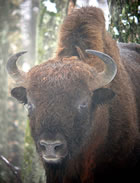 European Bison
European Bison
Bison bonasus
© John Muddeman
Poland: birds and bison in a winter landscape
by John Muddeman
Trip report extracts 12th - 20th February 2005
This was a ground-breaking tour for both The Travelling Naturalist and Limosa,
going to some of those areas usually visited in the spring, but this time in the
depths of winter. So why on earth choose to travel to somewhere typically freezing
cold and snow and ice-bound, instead of during the flush of spring? Well, it's
easy really, since winter brings a cloak of snow in which it is much easier to
track animals and see them in the woods where there are no longer leaves. At
least that's the theory…
Monday 14 February
The early risers followed in Bogdan's wake as he cruised round a different woodland circuit to the day before,
but not before watching a Brown Hare cross the frozen lawn and then nibble the bark on a tree. Very few birds were
evident however, with a calling Common Buzzard and drumming Black Woodpecker of most note. A fine
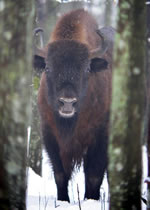 European Bison
European Bison
Bison bonasus
© John Muddeman
Great Spotted Woodpecker watched by the hotel was one of many present, their tappings could be heard just about
everywhere. T. and I however ventured out later, also hearing Black Woodpecker and also watching a small group
of stunning white-headed Long-tailed Tits, and best of all, a flock of 11 Waxwings which flew
over before landing in a tree top, giving fine scope views!
Breakfast was followed by a long 2-hourish drive (including our first Ravens) to get to the Borecka forest area,
where we remained all day. After arriving, within just minutes, half the group were admiring 20+ European
Bison which had come in from the forest to feed at a special feeding station on the edge of the reserve!
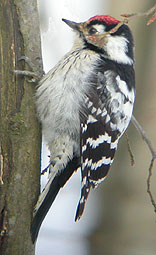 Lesser Spotted Woodpecker
Lesser Spotted Woodpecker
Dendrocopos minor
© John Muddeman
Those left behind, blissfully ignorant of what was round the corner, watched Tree Sparrows, Yellowhammers and Willow
and Marsh Tits along the road leading out from the forest in lovely sunny conditions. This was then soon reversed
and fortunately the majority of the bison still remained for the second group, giving fine views to all.
A brief bit of free time was usefully used by walking along the road into the edge of the wonderful mixed forest.
This proved to be excellent, with the above-mentioned birds all being observed in numbers, and after a short stretch
and just as we were about to turn back, a fine Middle Spotted Woodpecker fed quietly high up in an old oak, giving
good views to all, especially in the scopes, though remarkably, and much closer, a superb male Lesser
Spotted Woodpecker was working away feverishly on some small saplings almost at eye level, and basically
ignored us completely, giving stunning views.
The walk back was brisker, but some good Badger tracks added variety, though we were soon back off along the
snow-covered roads for lunch, this time of soup followed by zander, and very good it was too!
We returned after a leisurely lunch to be taken in two groups to a long series of high seats, though the deep
snow and treacherous conditions meant the time involved was considerable. At least those in the bus were treated
to fine views of a Black Woodpecker landing on a nearby tree to keep them occupied! Sadly, blanks were noted by
almost all, except a couple of Red Deer and a Pine Marten for P. and Black Woodpeckers for almost all those on
 Elk Alces alces
© John Muddeman
the earlier run, but the drive back gave 4 Brown Hares and 7 Red Deer for those in the bus and 28 European Bison
(!!) and a Red Fox in those in Marek's vehicle… The delays meant we finally arrived at 21:30 and dinner was
prolonged until 23:00!
Elk Alces alces
© John Muddeman
the earlier run, but the drive back gave 4 Brown Hares and 7 Red Deer for those in the bus and 28 European Bison
(!!) and a Red Fox in those in Marek's vehicle… The delays meant we finally arrived at 21:30 and dinner was
prolonged until 23:00!
Tuesday 15th February
A later, rather grey and slightly misty cold start at 7:15… Crested and Coal Tits, Siskins and Treecreeper were
the bird highlights by the hotel, but we rounded off by cutting back across the lake, where on opposite side netting
using a generator hauled out onto the ice was being carried out!
A very different morning was very fruitfully spent walking round a scientific animal breeding and research centre
at Kadzidlowo set up and run by Dr. Krzywinski. A super site in pastures and meadows in the forest, and the tone was
set when we walked into the first enclosure where "vulf, roe deer and elk are good friends"… And indeed
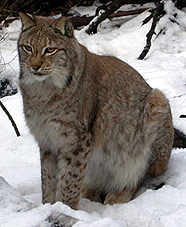 Boreal Lynx Felis lynx
© John Muddeman
they were!!! We also saw how Pine Martens can be discouraged from predating Black Woodpecker nests using miniature
electric fences around tree trunks (!) and heard that the woodpeckers apparently specifically nest in the trees in
the pens due to increased protection from smaller predators given the presence of larger predators, i.e. Wolf - a
remarkable idea and very plausible given 4 Black Woodpecker nests within the numerous enclosures!
Boreal Lynx Felis lynx
© John Muddeman
they were!!! We also saw how Pine Martens can be discouraged from predating Black Woodpecker nests using miniature
electric fences around tree trunks (!) and heard that the woodpeckers apparently specifically nest in the trees in
the pens due to increased protection from smaller predators given the presence of larger predators, i.e. Wolf - a
remarkable idea and very plausible given 4 Black Woodpecker nests within the numerous enclosures!
The route walked us through numerous pens where we (actually) rubbed shoulders with a huge Elk
and petite Roe Deer, and also contemplated Wolves at very close range, watched how a superb lowland Boreal
Lynx male played with Dr. Krzywinski's scarf and then refused to give it back (!), while a couple of charming
and playful Otters squeaked and squabbled, Black Grouse 'bubbled', young Chamois gambled on their little hill and Wild
Boar trundled round their pen, among many others! The food put out also attracts wild birds, including numerous Ravens
and two White-tailed Sea Eagles, plus single Middle Spotted and Black Woodpeckers, a Grey Heron and
large numbers of Yellowhammers. A Red Fox or two and a Red Squirrel or two (in fact the only ones we saw free-living!)
also put in brief shows, but it was sometimes hard to know exactly where to look!
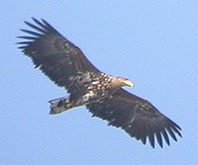 White-tailed Eagle
White-tailed Eagle
Haliaeetus albicilla
© John Muddeman
We rounded off by passing a duck pond full of surprising species, the mix covering from Arctic Europe to S Africa
to the Far East, and then into the area by his house a mixed bag of species, many of them either previously injured,
or held 'in quarantine' for the Polish authorities, or of captive-bred stock. Wild Tree Sparrows and a few Goldfinches
came in to feed on the food available. The tour de force though, beating first a male 'rackelhahn' followed by a
stunning male Black Grouse held on the hand, was a fine male Capercaillie which sat placidly on his
hand like a prized falconer's bird, and was a really astonishing sight, its huge beak just inches from his face!
After another excellent lunch at a dog-filled restaurant (both things being generally agreeable!) we were out at
high seats again, this time in certain luxury given a little carpeting on the floors and 6 windows on three sides for
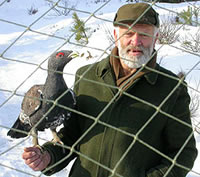 Capercaillie Tetrao urogallus
© John Muddeman
better viewing in more comfort. A mixed bag of sightings as usual, but including a Wild Boar sow with 7 piglets at
one hide, a single Wild Boar, 150+ Yellowhammers and a Tawny Owl at another and a few Roe and / or Red deer for
most of the rest. Not bad at all!
Capercaillie Tetrao urogallus
© John Muddeman
better viewing in more comfort. A mixed bag of sightings as usual, but including a Wild Boar sow with 7 piglets at
one hide, a single Wild Boar, 150+ Yellowhammers and a Tawny Owl at another and a few Roe and / or Red deer for
most of the rest. Not bad at all!
We got back with some time before dinner, where we then also celebrated a birthday!
Saturday 19th February
A typical pre-breakfast amble, but the slightly colder conditions meant it was crisper underfoot and even noisier
than normal! The birds were the same too, with Great Spotted Woodpeckers again seen, and on our return a high density
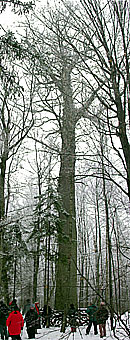 Oak sp. Quercus sp.
© John Muddeman
of Great Tits, plus a few other tit species. A local farmer also took a pot-shot with an air rifle at an over-inquisitive
dog which encroached on his land, which then prompted K. to mention that the hoteliers were also not averse to taking
pots shots with an air rifle at their own hotel, but in order to knock down the numerous icicles which were forming
on the edge of the thatch, then dropping down to the lower layer and damaging it!
Oak sp. Quercus sp.
© John Muddeman
of Great Tits, plus a few other tit species. A local farmer also took a pot-shot with an air rifle at an over-inquisitive
dog which encroached on his land, which then prompted K. to mention that the hoteliers were also not averse to taking
pots shots with an air rifle at their own hotel, but in order to knock down the numerous icicles which were forming
on the edge of the thatch, then dropping down to the lower layer and damaging it!
We were off at 5 to nine today, in order to pick up our guide for the day, who after various posts within the
Bialowieza National park, then became its director for 10 years, until retiring recently. His academic English was
terrific and we started our walk in the 'strict' part of the forest (i.e. where no motorised vehicle will ever be
allowed to go, or will anything be done to interfere with the natural processes underway). We started by contemplating
one or two of the trees present, including one of the largest oaks in the forest and towering up to 120 ft above the
forest floor. The extraordinarily diverse ages of all the species present and the amazingly straight trunks of the
trees were signs of the great age and absence of 'management' (= intervention) by man in the past. This was a feature
everywhere we went, including when some of the group stayed longer and saw the largest pussy willow tree (yes, a tree!)
in Europe.
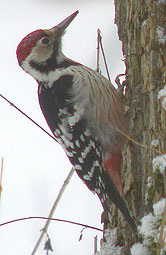 White-backed Woodpecker
White-backed Woodpecker
Dendrocopos leucotos leucotos
© John Muddeman
The group had spilt since several of us were all also suffering from an impressive cold one of the clients had
brought with her, and we wanted to return earlier. This actually proved to be in our favour since our return was much
slower, allowing J. to briefly spot a Pine Marten bounding over the snow, and as we neared the gate, so a superb
White-backed Woodpecker hammered away near the base of a dead stump! Considering that there were dozens and dozens
of Great Spotted Woodpeckers in the forest, this was no mean feat, these numbers being unknown before and undoubtedly
due to a major influx of N and/or E birds. In addition, as we walked out of the forest and back to the bus, four Red
Deer ran across a field and a fine White-tailed Eagle circled up and glided past. Sadly the remaining group did not
have this luck, though a Pygmy Owl sitting in a hole was spotted by a few when they stopped at a woodpecker-rich spot
including a single Lesser Spotted and several Middle Spotted Woodpeckers.
I was in bed, feverish and 'dead to the world' when most of the rest of the party went out again at dusk, this
time in search of Pygmy Owl with the aid of a local guide. Unfortunately, though birds had been there at 6:15 am,
they roam the forest following the tit flocks, and were not present, despite him imitating their calls for c. 30
minutes.
Sunday 20th February
Breakfast at 8 and away at nine, giving a few early risers the chance to watch for the Grey-headed Woodpecker
again at the fat, but 'only' Lesser, Middle and Great Spotteds turned up!
We sped towards Warsaw in crisp conditions, noting much heavier snowfall in some areas coating the trees with a
good covering, but also stopping for a fine Great Grey Shrike (the second on the same long stretch of wire) and also
noting good numbers of Grey Partridge, often right beside the road and sheltering at the base of trees. Single Brown
Hare and Red Fox were also noted out in the open, with a few Waxwings noted by Phil, and towards Warsaw in the towns,
Jackdaws, Rooks, Magpies and Hooded Crows becoming common again. Gulls in Warsaw included Black-headed and Common,
but we were unable to ID those large gulls going over, though some appeared to be Caspian…
 Warsaw Main Square
© John Muddeman
Warsaw Main Square
© John Muddeman
We walked through old Warsaw to a little restaurant where we ate our final meal together, then after another short
wander afterwards, returned to the bus where we said goodbye to three of the party (all of them staying for an extra
day in Warsaw) and soon reached the airport. Check-in was easy, we killed time buying drinks and /or gifts, then spent
ages to get through the ultra-sensitive metal-detectors, before getting away in good time.
John Muddeman
See John's wildlife tours this year
Wildlife holidays and tours in Spain and Portugal
|